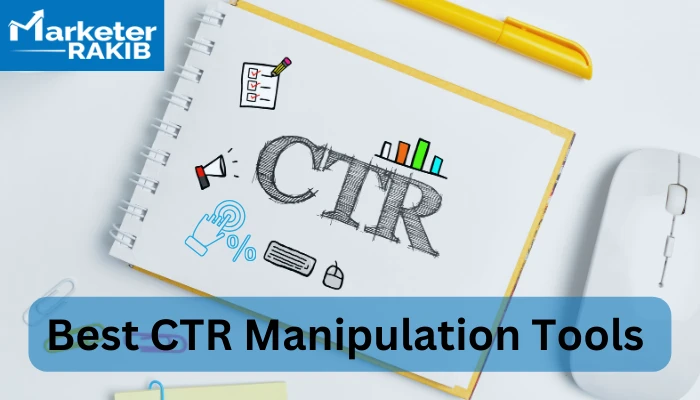Maximizing Organic Click-Through Fees With CTR Manipulation
The optimization of natural click-through prices (CTR) is a nuanced undertaking that rests on comprehending both customer psychology and effective content discussion. By leveraging strategic adjustment techniques, such as strongly crafted headings and aesthetically engaging aspects, marketers can substantially enhance individual involvement. The landscape is rife with mistaken beliefs and oversimplifications concerning what really drives CTR. As we check out the complexities of these approaches, it comes to be important to recognize the underlying concepts that can lead to sustained success in capturing audience attention. What really sets apart the efficient from the inefficient in this important element of electronic advertising and marketing?
Understanding Click-Through Fees
Recognizing click-through prices (CTR) is vital for evaluating the effectiveness of online marketing approaches. CTR gauges the portion of users that click a details link or advertisement contrasted to the overall number of users that see it. A higher CTR shows that the material is engaging and pertinent to the target audience, while a lower CTR might indicate a demand for optimization.
To compute CTR, split the number of clicks by the variety of impressions and increase by 100. As an example, if an ad obtains 300 clicks out of 10,000 perceptions, the CTR would certainly be 3%. This statistics is vital for examining various components of digital advertising and marketing, including seo (SEARCH ENGINE OPTIMIZATION), email projects, and social media advertising.
Moreover, examining CTR helps marketers determine which strategies produce the very best results and which call for refinement. By focusing on boosting CTR, companies can boost their material's presence and efficacy, causing raised web traffic and possible conversions. Understanding the nuances of CTR is fundamental for any marketing professional aiming to optimize their on the internet visibility and take full advantage of roi (ROI)

The Psychology of Individual Behavior
Individual actions is substantially influenced by mental factors that determine how people communicate with online web content. Comprehending these factors is crucial for enhancing click-through rates (CTR) in organic search outcomes.
Emotional actions also substantially influence individual behavior. Web content that resonates mentally can cause a sense of seriousness or inquisitiveness, prompting individuals to click. Additionally, social proof-- such as customer reviews or ratings-- can improve trust fund and encourage interaction, as individuals commonly look to the habits of others to notify their very own choices.
Moreover, the principle of shortage can drive clicks - CTR Manipulation Service. Limited-time offers or special web content develop a fear of losing out (FOMO), compelling individuals to act swiftly. Comprehending these mental drivers enables marketing professionals to develop even more engaging web content that reverberates with their target market
Reliable CTR Adjustment Strategies
Leveraging emotional understandings can dramatically boost click-through prices (CTR) with targeted control methods. One of one of the most efficient techniques is the usage of engaging headings that evoke curiosity or necessity. Wording titles as inquiries or integrating numbers can draw in even more attention, motivating customers to click.
An additional method includes optimizing meta summaries to develop a sense of importance and immediacy. By clearly outlining the options or benefits offered in the material, you can involve potential readers and encourage them to click. Furthermore, utilizing power words-- such as "exclusive," "confirmed," or "complimentary"-- can enhance the appeal of your web content.
Visual elements additionally play a crucial duty. Integrating attractive photos or thumbnails can attract users in and enhance CTR. A/B testing various visuals can help recognize which pictures reverberate finest with your audience.
Last but not least, making sure that your content assures deliverable value brings about greater CTR. When users perceive that clicking will provide them with significant insights click here to find out more or options, they are more probable to involve. By using these techniques attentively, online marketers can properly manipulate CTR to their benefit while keeping ethical requirements.
Usual Myths Concerning CTR
Several mistaken beliefs border click-through rates (CTR) that can lead online marketers to make illinformed choices. One widespread myth is that a higher CTR constantly converts to better performance. While a high CTR suggests that even more customers are clicking, it does not guarantee sales or conversions. Ultimately, the efficiency of traffic relies on the quality of the touchdown page and the importance of the content.
An additional usual belief is that CTR is an isolated metric. In truth, CTR should be assessed in conjunction with various other efficiency signs, such as bounce price and conversion rate, to acquire an alternative view of project success.
Furthermore, some marketing professionals presume that optimizing for CTR alone is enough. Concentrating solely on CTR can lead to clickbait strategies that might draw in clicks you can try here but fall short to engage users meaningfully. CTR Manipulation. This strategy can hurt brand track record and lead to reduced retention rates
Last but not least, there is a concept that CTR strategies are generally efficient. The fact is that ideal CTR methods can vary significantly throughout industries and target market, demanding tailored strategies for different market sectors. Understanding these misconceptions is important for creating efficient CTR approaches that align with overarching marketing goals.
Gauging CTR Success
Although high click-through rates (CTR) can indicate effective interaction with web content, measuring their true success requires an extensive evaluation of several aspects. Initially, it is important to recognize the context in which the CTR is achieved. As an example, a high CTR on a misleading title may not convert to purposeful engagement or conversions, ultimately showing inadequately on the brand name's reliability.
Second, assessing the source of web traffic is vital. Organic website traffic from search engines can signify a durable content strategy, while clicks from pointless sources may suggest a lack of targeting. In addition, gauging the succeeding customer actions is essential; assessing metrics such as bounce price, time invested in web page, and conversion prices can supply much deeper insights into the quality of the engagement initiated by the CTR.

Verdict

The optimization of organic click-through rates (CTR) is a nuanced venture that pivots on comprehending both user psychology and reliable content discussion. CTR measures the portion of users who click on a details link or promotion compared to the overall number of users who watch it. A higher CTR suggests that the web content is involving and relevant Find Out More to the target audience, while a lower CTR might signal a requirement for optimization.
Concentrating exclusively on CTR can lead to clickbait methods that may draw in clicks yet fail to involve users meaningfully. Furthermore, gauging the subsequent individual habits is essential; evaluating metrics such as bounce price, time invested on page, and conversion prices can provide deeper insights right into the top quality of the engagement started by the CTR.
Comments on “Open Higher Rankings with Efficient CTR Manipulation Approaches”